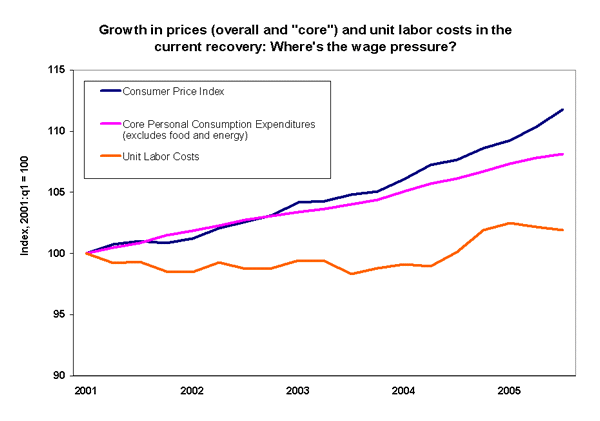See Snapshots Archive.
Snapshot for December 13, 2005.
The Fed’s Rate Hikes: Hunting Inflation, Killing Wages
When the Federal Open Market Committee (FOMC) meets on December 13, it is widely expected to raise interest rates for the 13th consecutive time, to 4.25%. The committee’s rationale is to head off price pressures, which some analysts fear will increase as an improving job market leads to wage growth.
Yet, as the accompanying chart shows, there is no evidence that wage pressure is driving up prices. The chart plots the growth in unit labor costs (ULCs) and two measures of prices: overall consumer prices and the “core” price index for consumption expenditures that excludes food and energy costs. All three measures are indexed to 100 and start in 2001q1, the beginning of the current business cycle. ULCs measure the labor cost to employers of producing one unit of output. Because labor compensation accounts for most of the cost of producing goods and services, ULCs are a closely watched gauge of cost pressures. Federal Reserve officials watch ULCs to determine whether compensation increases can be paid for out of productivity gains without leading to higher prices or tighter profit margins.

ULCs were essentially flat from 2001 through the third quarter of 2004; they then rose sharply for a few quarters before recently slumping again. Inflation, on the other hand, has risen consistently, and even accelerated in recent quarters when ULC growth actually decelerated. Obviously, other forces, particularly energy costs, are pushing up prices. Even when comparing ULCs to “core inflation” over the period covered in the chart, ULCs are up only 2%, while core inflation is up 8%.
These dynamics suggest the Fed is hitting the brakes too hard; with ULCs declining for the last two quarters, the Federal Reserve should clarify that further rate hikes do not seem appropriate. By continuing its relentless rate-hike campaign, the Fed can dampen any wage pressure coming from the job market, but that is not the source of current inflation. In fact, one the biggest challenges facing American workers right now is the historically large gap between overall economic growth and their paychecks. Productivity is up 17% over the cycle, yet real compensation is up only 7%, and real average wages (i.e., excluding benefit costs) are up by less than 1%.1 By tightening, the Fed makes it less likely that the living standards of working families will finally connect to the expanding economy.
Notes
1. The productivity and real compensation values come from the nonfarm business productivity accounts of the BLS. The real growth is the wage and salary component is from the Employment Cost Index.
This week’s Snapshot was written by EPI economists Jared Bernstein and L. Josh Bivens.
